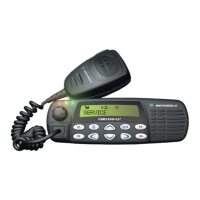3-2 Maintenance
not soaked with alcohol. Do not use high-pressure air to hasten the drying process since this could
cause the liquid to collect
in
unwanted places. Upon completion of the cleaning process, use a soft,
absorbent, lintless cloth to dry the area. Do not brush or apply any isopropyl alcohol to the frame, front
cover, or back cover.
Note:
Always use a fresh supply
of
alcohol and a clean container to prevent contamination
by dissolved material (from previous usage).
3.3
Safe Handling of CMOS and LDMOS
Complementary metal-oxide semiconductor (CMOS) devices are used
in
this family
of
radios. CMOS
characteristics make them susceptible to damage by electrostatic or high voltage charges. Damage
can be latent, resulting
in
failures occurring weeks or months later. Therefore, special precautions
must be taken to prevent device damage during disassembly, troubleshooting, and repair.
Handling precautions are mandatory for CMOS circuits and are especially important
in
low humidity
conditions.
DO NOT attempt to disassemble the radio without first referring to the CMOS CAUTION
paragraph
in
the Disassembly and Reassembly section
of
the manual.
CAUTION:
This radio contains static-sensitive devices. Do not open the radio unless you are
I properly grounded. Take the following precautions when working on this unit:
WARNING
Store and transport all CMOS devices
in
conductive material so that all exposed leads are
shorted together. Do not insert
CMOS devices into conventional plastic "snow" trays used for
storage and transportation
of
other semiconductor devices.
Ground the working surface of the service bench to protect the CMOS device. We recom-
mend using the Motorola Static Protection Assembly (part number 0180386A82), which
includes a wrist strap, two ground cords, a table mat, and a floor mat.
Wear a conductive wrist strap
in
series with a 100k resistor to ground. (Replacement wrist
straps that connect to the bench top covering are Motorola part number RSX-4015.)
Do not wear nylon clothing while handling CMOS devices.
Do not insert or remove
CMOS devices with power applied. Check all power supplies used for
testing CMOS devices to be certain that there are no voltage transients present.
When straightening
CMOS pins, provide ground straps for the apparatus used.
When soldering, use a grounded soldering iron.
If at all possible, handle CMOS devices by the package and not by the leads. Prior to touching
the unit, touch
an
electrical ground to remove any static charge that you may have accumu-
lated. The package and substrate may be electrically common. If so, the reaction
of
a dis-
charge to the case would cause the same damage as touching the leads.
3.4
General Repair Procedures and Techniques
Parts Replacement and Substitution
When damaged parts are replaced, identical parts should be used. If the identical replacement
component is not locally available, check the parts list for the proper Motorola part number and order
the component from the nearest
Motorola Communications parts center listed in the Piece Parts
Availability section
of
this manual (See Chapter 1
).
You
also need to review Motorola's Rework and
Repair Technical Reference manual, P/N 6880309853, which can be ordered from AAD at 1-800-
422-4210.
Rigid Circuit Boards
The family
of
radios uses bonded, multi-layer, printed circuit boards. Since the inner layers are not
accessible, some special considerations are required when soldering and unsoldering components.

